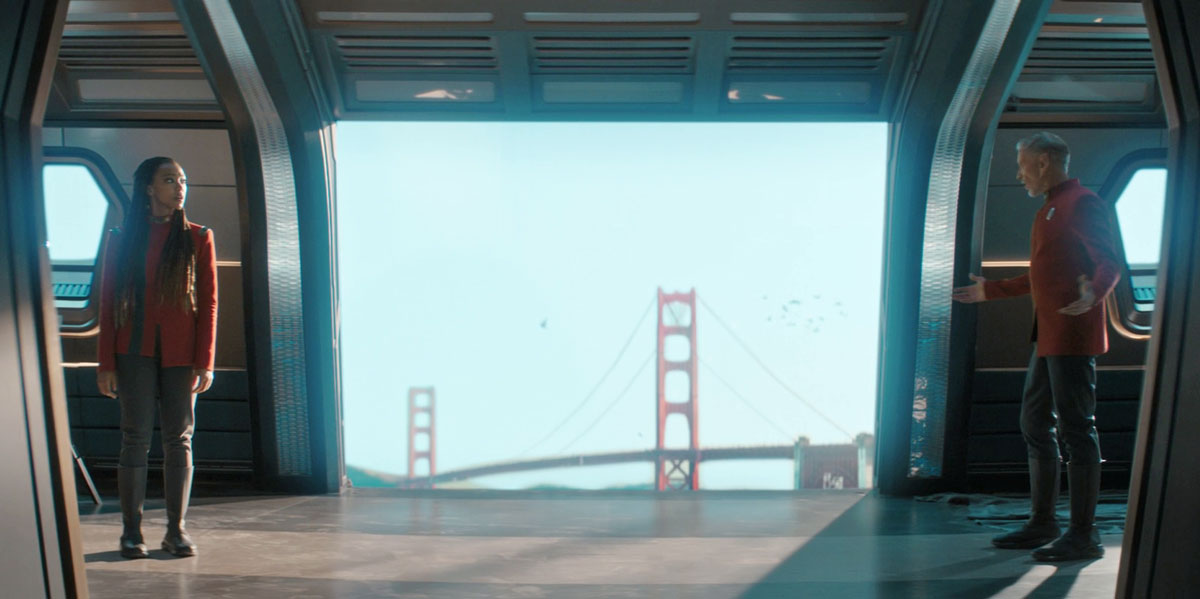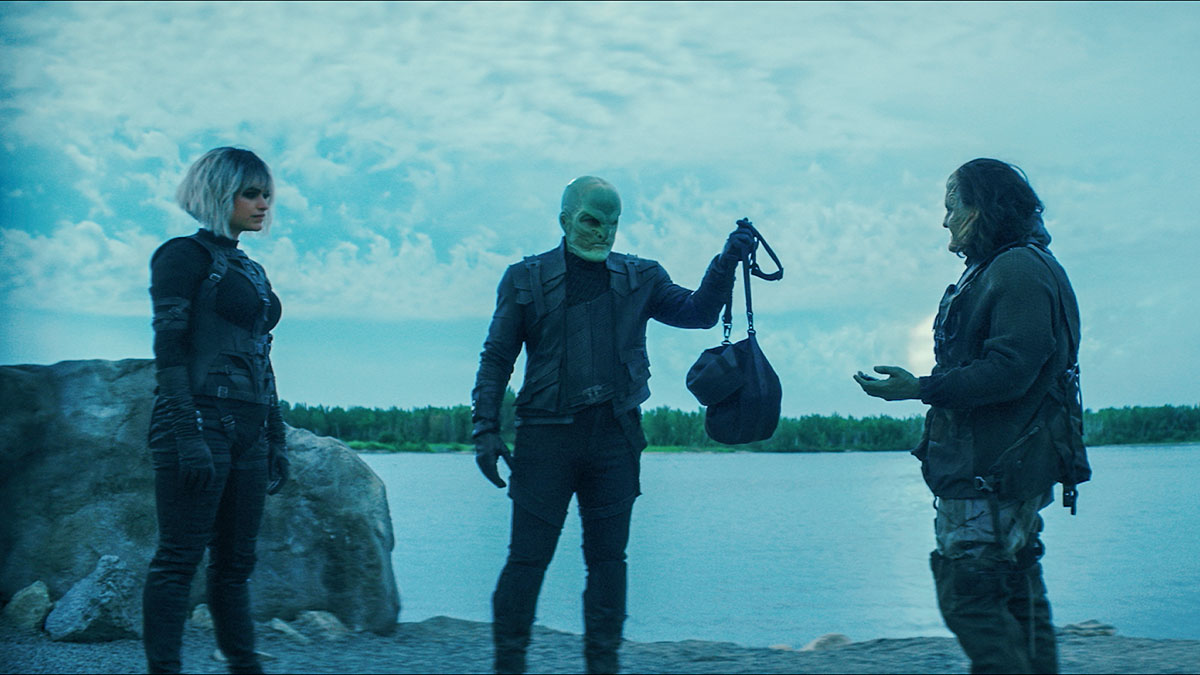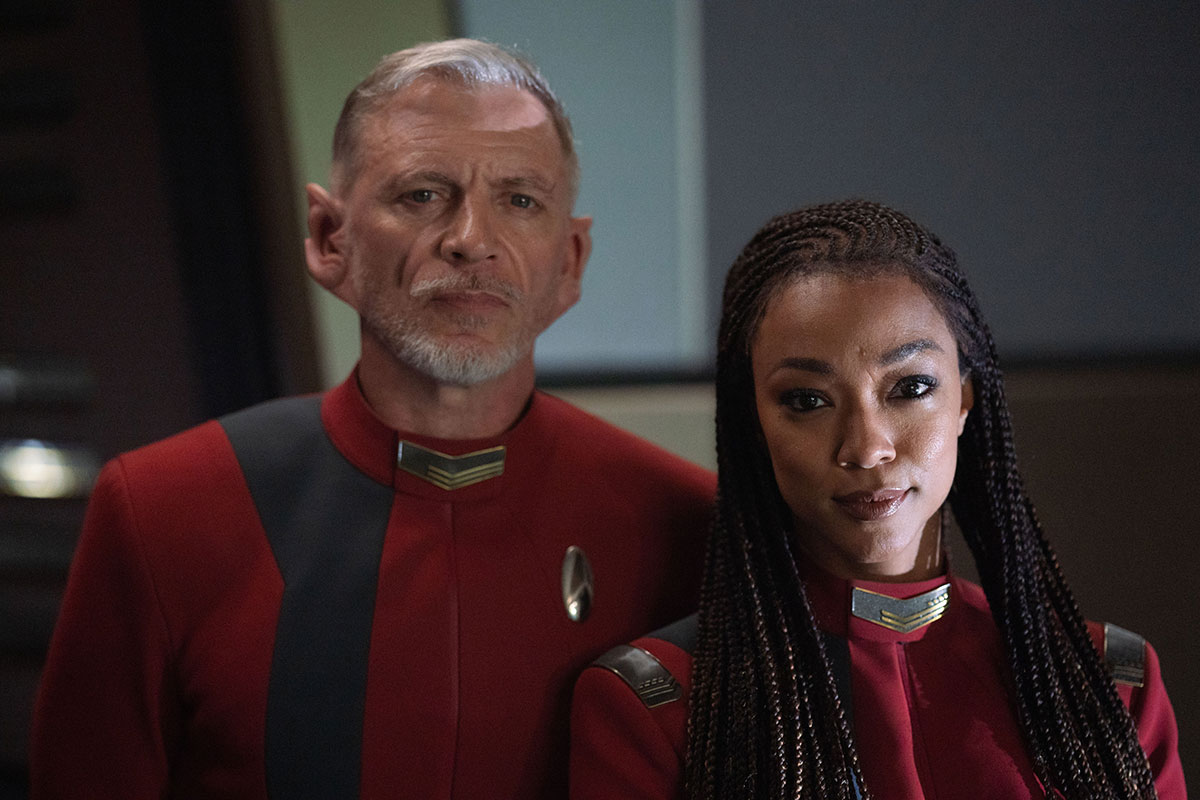Moll and L’ak’s attempts to sabotage Discovery’s efforts finally succeed and Burnham, Rayner, and Stamets are sent jumping through time where they have to face their pasts — and their future — to find a way back to the present before the Federation is lost. Wow, “Face the Strange”, right?! This was some really good stuff!
Discovery is at the coordinates of the next puzzle piece but nothing’s there: no ships, no planets, no distortions, no distress calls, no 1936 Ford pickups floating through space… none of the things that typically kick off the action in a Star Trek episode.
While Captain Burnham (Sonequa Martin-Green) polls the bridge crew for hypotheses and options, Rayner (Callum Keith Rennie) makes his impatience with her methods a little too known. She hits him with an “In my ready room” and they both transport themselves there instead of walking the 20 feet or whatever it is which, I’m sorry, is a little funny. To quote my good buddy Dean Winchester about some other people who teleport everywhere simply because they can, “You guys don’t walk enough, you’re gonna get flabby.”
Burnham lays it out for Rayner: he’s a member of this crew now, and he needs to work within it and with Burnham’s command style. Rayner thinks they’re all too familiar with each other, reminds Burnham that this is a Red Directive mission and that he feels that it’s not the time for leading by consensus. Just as Rayner is explaining to Burnham that he and his command style are products of The Burn and old habits die hard, the ship starts to malfunction around them. They cut the conversation short and return to the bridge.

Or, they try to. And okay, it turns out the gratuitous beaming was for good reason, story-wise, because in the instant that the pair attempt to beam back to the bridge, Discovery plunges through time, and only their mid-transport timing protects them from the ship’s time-hopping. Everyone else aboard Discovery is experiencing “regular” time travel, as it were, unaware of their movement and remaining “of the time” they jump to.
Everyone, that is, except for Paul Stamets (Anthony Rapp), who thanks to his tardigrade DNA infusion all the way back in Season 1, the scientist is bouncing through time like the rest of the crew — but he’s mentally aware of the jumping remains “himself” like Burnham and Rayner.
Like “Magic to Make the Sanest Man Go Mad,” this is another episode about time shenanigans centering on Stamets and Burnham (and now also Rayner), but it doesn’t feel like a repeat of the same story so much as a deliberate permutation on a theme. Discovery, the show, is revisiting its past just the same way Burnham revisits her past self here; in both cases, the future versions have grown and changed in ways their past selves could never have imagined.
Who could have guessed, watching the series’ seventh episode, that original showrunner and creator Bryan Fuller would leave after just one season and a majority of the show would end up taking place in 32nd century? Not me, that’s for sure.
(As a side note, I was hoping one of the pasts they visited would be the “Magic” situation, just because come on, who doesn’t want to see what a time loop within a time loop looks like?)

It takes them all a few time jumps to figure out what’s going on, and a few more after that for all three of them to rendezvous. The second jump takes them back to Discovery mid-construction, sitting in dry dock at the San Francisco Fleet Yards, the Golden Gate Bridge framed nicely in a missing bulkhead section. (Both Star Trek and The Room have one rule: If you’re in San Francisco, the Golden Gate Bridge must be visible at all times!)
Next jump is to the Season 2-ending battle with Control, and finally with three jumps there’s enough of a pattern visible for Rayner to identify what’s going on and what, exactly, is causing it. First, each time they jump Burnham and Rayner always return to the ready room – the place where they beamed themselves out of time — and second, that little mechanical spider that’s been crawling around the ship since it first detached itself from Adira’s uniform is a Krenim chronophage (yes, those Krenim) left over from more lawless times when paralyzing a ship by having it randomly cycle through time was a thing that apparently people did.
After a few more jumps, including one where a past version of Jett Reno (Tig Notaro) happens to save Rayner’s hide, he and Burnham land on an empty, dusty Discovery, abandoned by everyone except the one person who can’t leave: Zora (Annabelle Wallace). Listening to “Que Sera, Sera” and convinced that she’s dreaming, Zora explains that in this future, Discovery remained stuck in its time paralysis long enough for the Breen to get their hands on the Progenitor’s technology.

It’s a bleak future to visit, but it’s also very fortuitous that they did, because Zora is able to quickly do the math necessary for Stamets — who they finally meet up with in the next time jump –to figure out how to get them out of this. Just build a chroniton stabilizer and squish the bug with it, easy peasy!
And all Burnham has to do is get a component for it from her quarters without being seen. Not so easy as it turns out, as she runs into Book (David Ajala) who is very much in love with Burnham during this time period — and keen to show it. And she, as we all probably suspected, is still very much in love with him and gives herself a brief moment to indulge in that fact.
In their final final jump — this time to early in Lorca’s captaincy — Burnham runs into her much angrier and more jaded younger self; a Michael Burnham who is so barely out of prison that she still doesn’t even have a combadge and who flat-out does not believe this woman in a strange red uniform who claims to be her. Why? Because there’s no way anyone would ever make Michael Burnham a captain.
After a fight in a thankfully empty corridor, our Burnham ends up victorious and heads to the bridge… where she needs to convince everyone that they should listen to her and do something you never really want to do with a warp engine going at maximum speed: intentionally break the warp bubble and slam yourself back into the effects of general relativity.

Flashbacks are a tried and true way for shows to bring back departed characters, so the choice to include Airiam (Hanna Spear) on the bridge makes sense and is nice for audience members who miss her. What doesn’t really make a whole lot of sense to me is how her presence is used (which is a bit of an unfortunate parallel to her death for me – or at least the impact it was supposed to have).
Burnham knows she needs to convince the crew that she really is herself and that she really is from the future, but instead of, I don’t know, showing them her combadge which is full of 32nd century bells and whistles and exotic alloys that haven’t been invented yet she… convinces Airiam that they know each other because Burnham knows Airiam would sacrifice her life to save the ship? Then someone blurts out a “No she wouldn’t!” like that’s not the first thing any appropriately heroic Starfleet officer would do?
This scene is the one fumble in an otherwise great episode. Two minutes after this weird “I know you and here’s a generic hypothetical that applies to most people in Starfleet to prove it,” Airiam sees Burnham’s fancy holographic combadge and openly gawks at it. See, easily convinced! That would have worked and it wouldn’t have required the show to reexamine the hollowness of Airiam’s death without correcting its mistake.
The fact that Burnham doesn’t have anything better or more personal to say to or about Airiam except “You died, sorry that happened,” underscores just how undeveloped she was as a character. Why bring that up again? But hey, Burnham’s tactic works, and I suppose that’s what really matters here.

Meanwhile, past-Burnham and her era’s Rhys (Patrick Kwok-Choon) show up in engineering, phasers drawn, to try and stop Stamets and this weird guy they’ve never seen before from doing whatever it is that they’re trying to do to the ship. Rayner, solidifying himself as a solid gold example of a favorite character trope of mine — Grumpy Guy who’s a Secret Softie — defuses the situation by being brave as hell (he walks right into Burnham’s drawn phaser) but also emotionally astute.
He doesn’t just tell Burnham personal facts he couldn’t have known if he were really a stranger, he tells her with conviction that she really does deserve to be here on Discovery… something that sinks to the core of who she is and what she’s battling in this moment in time.
The plan succeeds: the time bug is proverbially squished, and Discovery and her crew are all right back where they belong, minus the six hours they lost during all the jumping. Unfortunately, those six hours were long enough for Moll and L’ak to catch up with them and leave again. Did they find anything, or did they get sick of looking at seemingly empty space and leave? We don’t know yet, so tune in next week.

Which brings us to the beginning of “Face the Strange” — see, I can jump through time too! — when we see Moll (Eve Harlow) and L’ak (Elias Toufexis) acquiring the bug in the first place. While the Progenitors’ technology is enormous in its power and implications and Moll and L’ak are willing to do just about anything to find it, their motivations seem strictly personal.
Sure, if the way Moll takes revenge on the guy who sells her the chronophage is any indication, they’ll get some personal satisfaction out of seeing the Federation burn, but more than anything they’re in it for their freedom. Freedom from someone or something, certainly – though who or what we still don’t know – but, given the themes in “Face the Strange”, I’d guess freedom from their pasts might be the real goal.
OBSERVATION LOUNGE
- “Face the Strange” is a reference to the David Bowie classic “Changes.”
- This episode is a spiritual sequel to Star Trek: Voyager’s “Shattered,” a similar final-season tale which saw Chakotay bouncing through different eras of Voyager adventures.
- Discovery’s time jumps include visits to the ship’s transit through the Red Angel wormhole (leading to the ship’s crash-landing in “Far From Home”), a time when the starship was under construction in the San Francisco Fleet Yards, the battle with Control (“Such Sweet Sorrow, Part 2”), Stardate 865422.4 (during Osyyra’s takover in “There Is A Tide…”), an unknown date nearly 30 years into the future, a period in early Season 2 (shortly after Jett Reno’s rescue in “Brother”), a point ahead of the Season 4 premiere after Burnham was promoted to captai), and the encounter with past-Burnham which takes place just ahead of “The Butcher’s Knife Cares Not for the Lamb’s Cry” (denoted by the reference to a still-alive Ellen Landry).

- Retrofit into corridor after Season 2’s set updates, the passage to the left-rear of Discovery’s command chair returns to its Season 1 “blue blinkies” configuration.
- Captain Pike’s broken wood-and-glass conference table returns to the ready room set during the first time jump, a good touch from the set decoration department.
- We’ve seen the San Francisco bay many times in Star Trek history… so just where in the heck was Discovery’s dry dock located?
- A Krenim chronophage — or “time bug” — snared Discovery in a time bubble, from the species behind Star Trek: Voyager’s “Year of Hell.”
- Season 3-era Reno’s drink of choice is a Vesper martini, served ice cold — and she tells Rayner that he can buy her a drink “at Red’s,” the onboard bar and lounge set added to Discovery during its 32nd century upgrades (though not introduced until Season 4).
- While the ready room set was not built for Discovery until Season 2, the second time jump confirms the room existed as part of the ship’s original construction… but in a continuity goof, the 32nd century version of the Starfleet emblem remains on the Discovery ready room floor in each different time period, instead of the old version seen in Seasons 1 and 2.

- Burnham gives a blink-and-you’ll-miss-it nostalgic smile when Stamets hands her a 23rd century Starfleet communicator, retired after the crew upgraded to 32nd tricombadges in Season 3’s “Scavengers.”
- Saurian officer Linus (David Benjamin Tomlinson) appears in the Season 1 time period, indicating he boarded Discovery long before his first actual appearance in Season 2’s “Brothers.”
- Former Discovery cast members Hannah Cheesman and Ronnie Rowe, Jr. return as Airiam and Bryce, Julianne Grossman returns as the original voice of Discovery’s computer. (While Cheesman portrayed Airiam in Season 2, the role was actually portrayed by Sara Mitich in Discovery’s first season.)
- I forgot just how much Airiam moves like C-3PO. Might have toned down that arm placement there in that wide shot if it were me, yikes.
- Discovery’s viewscreen may be an open window to space, but it features blast doors which can be closed as necessary.
- The future time period Burnham and Rayner visit is reminiscent of the alternate future setting in “Calypso,” where Zora and Discovery sat abandoned for nearly 1000 years. Zora even believes she’s having “another dream” when the officers arrive, perhaps hinting that the events of “Calypso” may have been one of Zora’s dreams — as the “Zora-point-of-view” shots mirror moments from that Short Trek tale.

- This episode marks the first time we’ve seen Discovery’s original hull and nacelle configuration since its big 32nd century upgrade in “Scavengers.”
- Even living “outside of time,” it’s curious that Stamets can jump back to a time period before his tardigrade DNA injection occurred.
- Stamets’ tactics for clearing engineering get less and less sophisticated as the episode proceeds — going from making up specific problems with the spore drive containment field to just shouting “I’m grumpy!” It works.
- “Hey Paul, let’s show ‘em how a couple of old dogs still know the best tricks!” Whoever gave Rayner a used copy of a dictionary of idioms from 1962, I thank you for your service.
- Rayner’s hand gets the “Timescape” treatment, aging uncomfortably fast while he squashes the time bug — though thankfully avoiding those awful long fingernails.
- Rayner surmises that Burnham must be the first person in Starfleet to captain a ship she first boarded as a prisoner. He’s probably right, but if we allow for a few technicalities I’d put Seven of Nine in that rare club as well: she’s imprisoned very quickly after boarding Voyager, and while she doesn’t hold a Starfleet rank at the time, she does command that vessel for over a month during the events of “One”.

Even with all the time jumping and the temporal-relativity-heavy plot, “Face the Strange” is a straightforward hour of television that confidently knows exactly what it wants to do – both in terms of the story and the characters. There are almost no extraneous moments, but the episode doesn’t feel rushed or overly full. The pacing is great: quick enough that we get to jump through a lot of different time periods, but relaxed enough that there’s room for smaller moments of comedy and character work.
The pacing and placement of the more emotional moments is especially effective, with characters examining and confronting their past and present selves in a way that’s emotionally resonant but also truly moves the story forward both at the episode and season levels.
A frequent frustration I have with Discovery is that the emotional beats and plot beats feel like they’re competing with each other for the same space, but with “Face the Strange” it feels like the show has finally figured out a way to have them work together and compliment one another.
![]()
Star Trek: Discovery Season 5 returns with “Mirrors” on Thursday, April 25.
